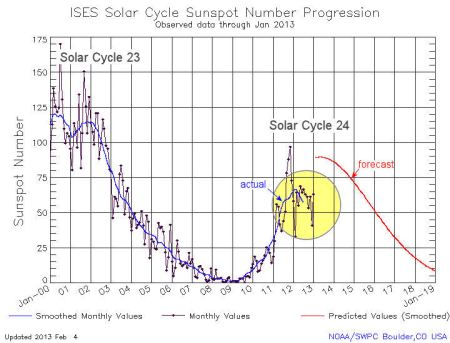Like Icarus the global warming believers pay little attention to the sun and its moods. But like the wings of Icarus the demonisation of carbon dioxide is likely to be demolished by the sun. We are now in Solar Cycle 24 and magnetic flux and sunspots continue to be lower than the already low forecasts for this cycle. The Landscheidt minimum approaches and the sun is entirely oblivious of fanciful theories about coming ice ages or the melting of the polar ice caps. The sun will not be denied. The earth will merely adapt to whatever the sun deigns to produce and it might be best if we focused on adapting to whatever the sun does and waste less time on trying to control the climate.

Say Goodbye to Sunspots?
Science reports a new paper submitted to the International Astronomical Union Symposium No. 273, an online colloquium showing that the dearth of sunspots is at an unprecedented low level.
The sun goes through an 11-year cycle, in which the number of sunspots spikes during a period called the solar maximum and drops—sometimes to zero—during a time of inactivity called the solar minimum.The last solar minimum should have ended last year, but something peculiar has been happening. Although solar minimums normally last about 16 months, the current one has stretched over 26 months—the longest in a century. One reason, according to the paper is that the magnetic field strength of sunspots appears to be waning.
After studying sunspots for the past 2 decades the authors have concluded that the magnetic field that triggers their formation has been steadily declining. If the current trend continues, by 2016 the sun’s face may become spotless and remain that way for decades—a phenomenon that in the 17th century coincided with a prolonged period of cooling on Earth. Sunspots disappeared almost entirely between 1645 and 1715 during a period called the Maunder Minimum, which coincided with decades of lower-than-normal temperatures in Europe nicknamed the Little Ice Age. But Livingston cautions that the zero-sunspot prediction could be premature. “It may not happen,” he says. “Only the passage of time will tell whether the solar cycle will pick up.” Still, he adds, there’s no doubt that sunspots “are not very healthy right now.” Instead of the robust spots surrounded by halolike zones called penumbrae, as seen during the last solar maximum (photo), most of the current crop looks “rather peaked,” with few or no penumbrae.
Over a year ago Henrik Svensmark, Professor, Technical University of Denmark, Copenhagen warned “In fact global warming has stopped and a cooling is beginning. No climate model has predicted a cooling of the Earth – quite the contrary. And this means that the projections of future climate are unreliable.”
It’s important to realise that the Little Ice Age was a global event. It ended in the late 19th Century and was followed by increasing solar activity. Over the past 50 years solar activity has been at its highest since the medieval warmth of 1000 years ago. But now it appears that the Sun has changed again, and is returning towards what solar scientists call a “grand minimum” such as we saw in the Little Ice Age.
The match between solar activity and climate through the ages is sometimes explained away as coincidence. Yet it turns out that, almost no matter when you look and not just in the last 1000 years, there is a link. Solar activity has repeatedly fluctuated between high and low during the past 10,000 years. In fact the Sun spent about 17 per cent of those 10,000 years in a sleeping mode, with a cooling Earth the result.
image: http://solarcycle24.com/sunspots.htm








